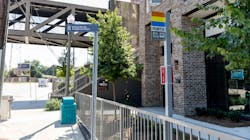BRT Stations Create Opportunities for Modern Amenities, Elevated Experiences and Economic Development
Bus rapid transit (BRT) stations are unique for several reasons, but at the most basic level they establish a sense of permanence not seen in the traditional fixed-route stations that can be subjected to route changes and discontinued use. Because of this, the Metropolitan Atlanta Rapid Transit Authority (MARTA) is finding more generated interest in its future BRT stations, particularly in the development community.
MARTA’s future stations for its Summerhill BRT corridor aim to offer a modern experience with community programming, as well as spur economic development that focuses on affordable housing. And with these goals, MARTA is further enhancing its place as a community asset.
BRT Stations Spur Economic Development
As mentioned, developers and investors are already showing interest in funding projects along the BRT corridor. In March 2022, MARTA and the Goldman Sachs Urban Investment Group within Goldman Sachs Asset Management (Goldman Sachs) broke ground on the Skyline Apartments, a transit-oriented development (TOD) with 250 units of affordable housing located across the street from the southern terminus of the Summerhill BRT line.
This TOD project is made possible through a greater partnership between MARTA and Goldman Sachs that established a $200 million initiative to finance new development at or within a mile of MARTA stations. While MARTA does not have money in this initiative, it did establish the criteria for the program to advance equitable investment and development near transit.
The partnership is part of the Greater Atlanta Affordable Housing TOD Initiative, which is a flexible, multi-product program designed to promote and support the development of ground-up mixed-income, TOD and affordable housing projects that benefit from proximity to MARTA’s 38 heavy-rail stations, 12 Atlanta Streetcar light-rail stops and in new transit investment corridors—such as the Summerhill BRT corridor.
MARTA Senior Director of Transit-Oriented Development and Real Estate Jacob Vallo shares he sees this as an encouraging sign from the development and investment communities, adding that MARTA is just now being included in real estate marketing packages for large development projects if it’s near heavy rail.
“What my hope is, is that the bus rapid transit does get that same level of respect because it does provide that level of connectivity that's important and it is an amenity for tenants,” Vallo said. “I do think it's that evolution of permanence. Bus stops being just as critical, but from a dollar investment or the significance of the capital investment, the development and the investment community certainly sees that permanence and is attracted to it.”
On top of increased investment, the initiative with Goldman Sachs and MARTA is also helping address equity by increasing affordable housing and partnering with Black-owned and Black-led, and particularly Black women-led, organizations and developers to construct the TOD projects.
“If we have access to capital that could benefit someone’s projects [then] you make those connections because ultimately it lifts up the entire community along that corridor,” Vallo said.
Modern Amenities for a Modern Service
Brand new TODs won’t be the only feature of the Summerhill BRT corridor. The service will feature 16 stops with modern amenities to enhance the customer experience and increase connectivity and safety.
For instance, MARTA created a Pedestrian Connection Inventory to assess the sidewalk infrastructure around several of its future BRT stations. The inventory includes field visit findings that identified deficiencies such as broken sidewalk pavers, necessary ADA ramp improvements, limited pedestrian lighting and other pedestrian connection challenges due to grade crossings. MARTA is working with the Atlanta Department of Transportation, the Georgia Department of Transportation, Norfolk Southern, the Atlanta BeltLine and private property owners to address these issues.
Other features of the service include 85 percent dedicated lanes, transit signal priority, off-board fare collection, real-time information and two pedestrian hybrid beacons. At each station, riders will experience level platform boarding, station signage and screens with route map information, lean rails, station phone with white light, ramps with mesh panels, polycarbonate roof, window, benches and guardrails with integrated artwork panels.
A Bigger Footprint Opens Opportunities
Typical customer amenities like real-time information and customized shelters won’t be the only things elevating the customer experience. With a permanent and larger footprint, MARTA is thinking outside the box on how else it can capitalize on its BRT stations. One example is expanding the agency’s Fresh MARTA Market from its heavy-rail stations to BRT stations.
Vallo explains as of now, the agency is focusing on the southern terminus for the fresh markets to conceptualize the idea but will focus on stations with the highest ridership that presumably will have the most customers that can benefit from having better access to fresh produce.
“We want to make sure that, if we pass the first couple of filters, okay, there's great ridership, there's a physical location opportunity for it; we also want to make sure that it's in the food insecurity area as identified in the USDA,” Vallo said.
Vallo notes the agency may also consider adding food vending machines at its future transit hubs – which primarily serve bus routes—like at its heavy rail stations. However, he adds MARTA may reexamine the options available to promote a healthier lifestyle to better position transit as a public health good, as well as align with its contribution to the wellness program StationSoccer.
StationSoccer is a program run by Soccer in the Streets, an Atlanta-based nonprofit organization. The program launched at MARTA’s Five Points Station on the plaza level, creating the first soccer field project inside a train station in the world according to the nonprofit. MARTA is hoping to expand StationSoccer to the terminus locations of Summerhill BRT, but each BRT station can be evaluated on a case by case basis. Vallo shares these types of programs can add value to stations and other transit facilities.
“As we begin to think about early activation, we can talk about the bigger TOD, but how can we be impactful today or tomorrow, because these TODs take a long time,” Vallo said. “So, what can we do to help address some of the mayor's concerns about activating some of these surface parking lots? Arts are a great way to do that.”
And StationSoccer isn’t the only community program offered at MARTA. MARTA also hosts dance, theatre and live music events at its passenger facilities that could potentially expand to the future BRT stations. These live music, dance and theatre events are part of the greater Artbound public art program, which also includes murals and other visual art. MARTA’s goal with public art is to “bring joy to the experience,” says Vallo, and in working on the Summerhill BRT corridor, project teams are more open to having an art director at the table to enhance the project.
“I think functionality is expected, but to go above and beyond, you need to really affect or positively impact the senses visually,” Vallo said. “The customer expects that the thing works. You're not getting credit for it just working. You're getting dinged if it's not working, but I think in order to get ridership back, we need to be focusing on some of these soft things.”
Future Prosperity
A growing interest in the development and investment communities and the opportunity to educate them on how bus service is an amenity to their projects, along with the introduction of a new mode of transit service that offers new amenities and a new approach to bus stations has Vallo excited for the region.
“I think our region has a really exciting opportunity to continue to deliver these projects and benefit the community, but also deliver infrastructure projects that are seen as significant and permanent, and relative to the development and investment community,” Vallo added. I'm optimistic about our region.”

Megan Perrero | Editor in Chief
Megan Perrero is a national award-winning B2B journalist and lover of all things transit. Currently, she is the Editor in Chief of Mass Transit magazine, where she develops and leads a multi-channel editorial strategy while reporting on the North American public transit industry.
Prior to her position with Mass Transit, Perrero was the senior communications and external relations specialist for the Shared-Use Mobility Center, where she was responsible for helping develop internal/external communications, plan the National Shared Mobility Summit and manage brand strategy and marketing campaigns.
Perrero serves as the board secretary for Latinos In Transit and is a member of the American Public Transportation Association Marketing and Communications Committee. She holds a bachelor’s degree in multimedia journalism with a concentration in magazine writing and a minor in public relations from Columbia College Chicago.


